Related Research Articles

George Edward Pickett was a career United States Army officer who became a major general in the Confederate States Army during the American Civil War. He is best remembered for being one of the commanders at Pickett's Charge, the futile and bloody Confederate offensive on the third day of the Battle of Gettysburg that bears his name.

Lewis Addison Armistead was a career United States Army officer who became a brigadier general in the Confederate States Army during the American Civil War. On July 3, 1863, as part of Pickett's Charge during the Battle of Gettysburg, Armistead led his brigade to the farthest point reached by Confederate forces during the charge, a point now referred to as the high-water mark of the Confederacy. However, he and his men were overwhelmed, and he was wounded and captured by Union troops. He died in a field hospital two days later.

Lafayette McLaws was a United States Army officer and a Confederate general in the American Civil War. He served at Antietam and Fredericksburg, where Robert E. Lee praised his defense of Marye's Heights, and at Gettysburg, where his division made successful assaults through the Peach Orchard and Wheatfield, but was unable to dislodge Union forces from Cemetery Ridge. After the Knoxville Campaign, he was court-martialed for inefficiency, though this was overturned for procedural reasons. Finally he was sent to his native Georgia to resist Sherman's March to the Sea, but had to retreat through the Carolinas, losing many men through desertion, and is presumed to have surrendered with Joseph E. Johnston in April 1865.
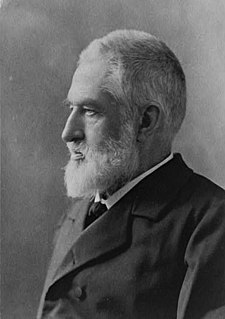
Jedediah Hotchkiss, known most frequently as Jed, was a teacher and the most famous cartographer and topographer of the American Civil War. His detailed and accurate maps of the Shenandoah Valley are credited by many as a principal factor in Confederate General Stonewall Jackson's victories in the Valley Campaign of 1862.

John Pelham was an artillery officer who served with the Confederate cavalry under J.E.B. Stuart during the American Civil War. He was called "The Gallant Pelham" by Robert E. Lee for his use of light artillery at Fredericksburg to significantly delay Union soldiers during the Civil War.

Virginia became a prominent part of the Confederacy when it joined during the American Civil War. As a Southern slave-holding state, Virginia held the state convention to deal with the secession crisis, and voted against secession on April 4, 1861. Opinion shifted after April 15, when U.S. President Abraham Lincoln called for troops from all states still in the Union to put down the rebellion, following the capture of Fort Sumter. The Virginia convention voted to declare secession from the Union on April 17. A Unionist government was established in Wheeling and the new state of West Virginia was created by an act of Congress from 50 counties of western Virginia, making it the only state to lose territory as a consequence of the war.
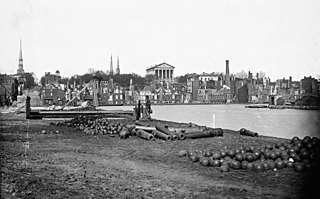
Richmond, Virginia served as the capital of the Confederate States of America for almost the whole of the American Civil War. It was a vital source of weapons and supplies for the war effort, and the terminus of five railroads.
The American Civil War bibliography comprises books that deal in large part with the American Civil War. There are over 60,000 books on the war, with more appearing each month. Authors James Lincoln Collier and Christopher Collier stated in 2012, "No event in American history has been so thoroughly studied, not merely by historians, but by tens of thousands of other Americans who have made the war their hobby. Perhaps a hundred thousand books have been published about the Civil War."
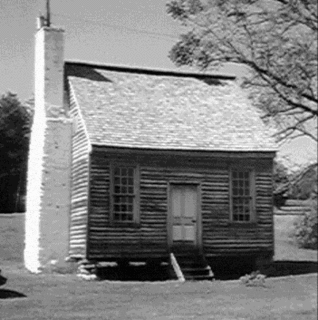
The Charles Sweeney Cabin is a structure within the Appomattox Court House National Historical Park. It was registered in the National Park Service's database of Official Structures on June 26, 1989.
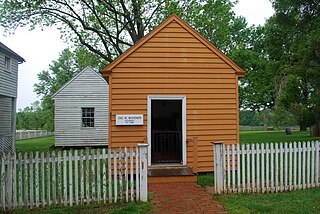
The Woodson Law Office is a structure within the Appomattox Court House National Historical Park. It was originally built by Samuel McDearmon in 1854 and rented by Woodson for his law office until he purchased it a couple of years later. It is a small structure and was built next to the main general store of Appomattox.

The Peers House is a structure within the Appomattox Court House National Historical Park. It was registered in the National Park Service's database of Official Structures on June 26, 1989.

The Bocock–Isbell House is a structure within the Appomattox Court House National Historical Park. It was registered in the National Park Service's database of Official Structures on June 26, 1989.
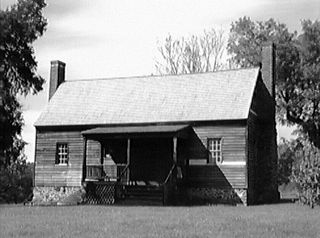
The Mariah Wright house is a structure within the Appomattox Court House National Historical Park. It was registered in the National Park Service's database of Official Structures on June 26, 1989.
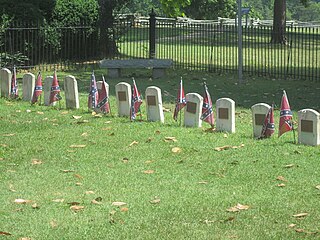
The Appomattox Court House National Historical Park cemeteries are part of the Appomattox Court House National Historical Park, which was listed on the National Register of Historic Places on June 26, 1989.

The Sweeney Prizery is a structure within the Appomattox Court House National Historical Park. It was registered in the National Park Service's database of Official Structures on June 26, 1989.
This bibliography of Abraham Lincoln is a comprehensive list of written and published works about or by Abraham Lincoln, the 16th president of the United States. In terms of primary sources containing Lincoln's letters and writings, scholars rely on The Collected Works of Abraham Lincoln, edited by Roy Basler, and others. It only includes writings by Lincoln, and omits incoming correspondence. In the six decades since Basler completed his work, some new documents written by Lincoln have been discovered. Previously, a project was underway at the Papers of Abraham Lincoln to provide "a freely accessible comprehensive electronic edition of documents written by and to Abraham Lincoln". The Papers of Abraham Lincoln completed Series I of their project The Law Practice of Abraham Lincoln in 2000. They electronically launched The Law Practice of Abraham Lincoln, Second Edition in 2009, and published a selective print edition of this series. Attempts are still being made to transcribe documents for Series II and Series III.
The American Civil War bibliography comprises books that deal in large part with the American Civil War. There are over 60,000 books on the war, with more appearing each month. There is no complete bibliography to the war; the largest guide to books is over 40 years old and lists over 6,000 titles.
The American Civil War bibliography comprises books that deal in large part with the American Civil War. There are over 60,000 books on the war, with more appearing each month. There is no complete bibliography to the war; the largest guide to books is over 40 years old and lists over 6,000 titles.
On June 20, 1863 the U.S. government created a new state from 50 western counties of Virginia to be named "West Virginia". This was done on behalf of a Unionist government in Wheeling, Virginia, approved by Congress and President Lincoln, though it was done with a low participation of the citizens within the new state. There remained a large number of counties and citizens who still considered themselves as part of Virginia and the Confederacy which, in turn, considered the new state as part of Virginia and the Confederacy. In 1861 the 50 counties contained a population of 355,544 whites, 2,782 freemen, 18,371 slaves, 79,515 voters and 67,721 men of military age. West Virginia was the 6th most contested state during the war, with 632 battles, engagements, actions and skirmishes.
References
- ↑ See, e.g., Glatthaar, Joseph, General Lee's Army: From Victory to Collapse (Simon and Schuster, 2008), ISBN 0-684-82787-5; Sheehan-Dean, Aaron, ed., The View from the Ground Experiences of Civil War Soldiers (Univ. Ky. Press, 2007), ISBN 0-8131-2413-1; Greene, A. Wilson, Civil War Petersburg: Confederate City in the Crucible of War (University of Virginia, 2006), ISBN 0-8139-2570-3; Carmichael, Peter, The Last Generation: Young Virginians in Peace, War, and Reunion (UNC Press, 2005), ISBN 0-8078-2948-X; Cashin, Joan, The War was You and Me: Civilians in the American Civil War (Princeton Univ. Press, 2002), ISBN 0-691-09174-9; Rable, George C., Fredericksburg! Fredericksburg! (UNC Press, 2002), ISBN 0-8078-2673-1; Simon, John, et al., The Lincoln Forum: Rediscovering Abraham Lincoln (Fordham Univ. Press, 2002), ISBN 0-8232-2215-2; Hess, Earl, Pickett's Charge--the Last Attack at Gettysburg (UNC Press, 2001), ISBN 0-8078-2648-0; Blair, William, Virginia's Private War: Feeding Body and Soul in the Confederacy, 1861-1865 (Oxford Univ. Press, 1998), ISBN 0-19-511864-2; Power, J. Tracy, Lee's Miserables: Life in the Army of Northern Virginia from the Wilderness (UNC Press, 1998), ISBN 0-8078-5414-X; Sutherland, Daniel, Fredericksburg and Chancellorsville: The Dare Mark Campaign (Univ. of Nebraska Press, 1998), ISBN 0-8032-4253-0.
- ↑ "Virginia's Civil War, A Guide to Manuscripts at the Virginia Historical Society". The Virginia Historical Society. Retrieved April 27, 2008.
- ↑ "VBA History and Heritage". The Virginia Bar Association. Archived from the original on May 15, 2008. Retrieved April 27, 2008.